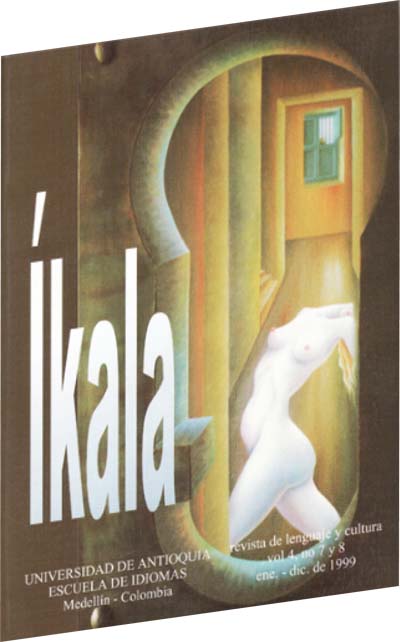De modelos tradutivos e traduções modelo para a tradução como modelo: algumas implicações para a tradutologia e a didática da tradução
DOI:
https://doi.org/10.17533/udea.ikala.8493Palavras-chave:
história da tradução, tradução como um processo, ensino da tradução, tradução pós-colonialResumo
O recente desenvolvimento das ciências da tradução conferiu uma nova identidade e esta disciplina: já não se concebe como um produto, mas, ao contrário, como um processo. As consequências dessa nova concepção devem ser consideradas ao elaborar programas de formação em tradução, tanto no âmbito curricular como no metodológico. Da mesma maneira, a qualidade no ensino da tradução vê-se transformada ao considerar a tradução, por uma parte, como metáfora e modelo em si, e, por outra, como um processo aberto, democrático e criativo.
Downloads
Referências
S. BASSNETT, A. LEFEVERE, Constructing cultures, Multilingual Matters, Clevedon, England, 1998.
"Uber die verschieden Methoden des Ubcrsetzens" (1813), reprinted in Hans Joachim Storíng (ed), Das Problem des Ubersetzens, Darmstadt, 1969.
J. BEER (ed), Medievalrranslarars and theircrafl, Westc.m Michigan Universíty, Medieval lnstitute Publícations, 1989, p.2.
M. CRONIN, Translatlng lre/and. Translation, languages , culture, Cork University Press, 1996, p.6.
See in particular S. SI.MON, Gender In translation, Roullcdge, London, l996.
A. LEFEVERE, "Chinese and Western thinking on translation", in S. Bassneu, A. Lefevcre, Construeling cultures, op. cit., pp. 12-24.
R. JACQJEMOND, "Translatioo and cultural hegemony: The case of French-Arabic
Translation", in L. Venuti (ed.), Rethinlcing translation. Discourse, suhjectMry, ideology, Routledge, London, l992, pp. 139-58.
J. ABBOUSRI DALLAL, "The perils of occidentalism. How Arab novelists arcdriven to wrilc for Wcstcm readers", Times Lilerary Supplement (London), No. 4960, 24 April
, pp. 8-9.
L. VENUTI (ed.), Rethinlring translatwn. Discourse, subjecliviry, ideology, op. cit., introductíon, pp. 1•17, and the translaror’s invisibility. A historyoftron.slation, Routlcdgc, Loodon, l995.
H. GONCAL VES BARBOSA, "Transaltion: Brazil", in V. Smith(ed), EnyclopediooflAJín American Literalure; Fitzroy Dearborn Pubüshcrs, London, 1997, p. 798.
Cited by D. OERDES, '"l'ranslation: Spanish America", in V. Smith, op. cit., p. 800.
M. SAYERS PIIDEN, "Mario Vargas Llosa in English translation. A survey of translator reception", ldeas '92, Vol. 2/1, 1992,citedby O. Oerdes, in V. Smith, op. cit., p. 801 .
L. VENUTI, The scandals of translation, Roudcdcge, London, 1998, p. 48.
Op. cit., p. 49.
A. LEFEVERE, Translating literature. Practice and theory in a comparative literature context, Modern Language Association of America, New York, 1992, p. 7.
S. BASSNETT, Translation studies (revised edition), Routledge, London, 1991, p. l6.
J. P. VlNAY & J. DARBELNET (1958), Stylistique comparés du français et de l'anglais: méthode de traduction, Beauchemin,
Montreal, 1977; P. NEWMARK, A textbook of translation. Prentice Hall, New York 1987.
A. LEFEVERE, op. cit., p.8.
L. VENUTI, The scandals of translation, op. cit., p.21.
O. ROBINSON, Becoming a translator, Routledge, London, 1997, pp. l92ff.
J. CULLER, literary theory. A very short introduction, Oxford University Press, 1997, p. IS.
D. ROBINSON, op. cit., p.SI.
lbid, p.292.
S. PINKER. The language instinct. The new science of language and the mind, Allen Lane/ The Penguin Press, London, 1994.
L. VENUTI, The translator’s invisibility. A history of translation, op. cit.
T. NIRANJANA, Siting translation. History, post-structuralism and the colonial context, University of California Press, 1992, p. l.
L. VENUTI, The scandals of translation, op. cit., p. 10.
S. BUDICK, W. ISER (eds.), The translatability of cultures, Stanford University Press, 1996.
J. CLIFFORD, Routes. Travel and translation in the late twentieth century. Harvard University Press, 1997.
S. BASSNE1T, A. LEFEVERE, Constructing cultures, op. cit., p.137.
Theory of the earth, t79S
M. CRONIN, op. cit.
J. CLIFORD, op. cit.
E. CHEYFITZ, expanded edition, University Of Pennsylvania Press, 1997.
D. ROBINSON, Northem Illinois University Press, 1996.
J. ASSMANN, in S. Budick, W. Iser, The Translatability of Cultures, op. cit., pp. 25-36.
H. RAM, IN A. DlNGWAY, C. MAIDER (eds.), Between languages and cultures, University of Pittsburgh Press, 199S, pp. 199-222.
S. MASINOALE BBLL, ibid. pp. 51-74.
L. KARAMCHETI, ibidem, pp. 181 - 197.
L. VENUTI, Tire translator's invisibility. A history of translation, op. cit.
L. VENUTJ, The scandals of translation, op. cit., p. 11. The term "remainder", taken from Lecercle, refers to the "minor variables" lo a "major form" which dominates a language at a given time.
lbid. p.ll.
S. BASSNETT, A. LEFEVF.RE, Constructing cultures, op. cit. P. l.
For some interesting examples, see the two important articles: C. MAIER, "Towards a Theoretical practice for cross-cultural translation", and A. DINOWANEY AND C.
MAIER, "Translation as a method for cross-cultural teaching", both in A. Dingwaney, C. Maier (eds.), Between languages and cultures, op. cit, pp.21-38 and 303-319.
Downloads
Publicado
Como Citar
Edição
Seção
Licença
Copyright (c) 1999 Íkala, Revista de Lenguaje y Cultura

Este trabalho está licenciado sob uma licença Creative Commons Attribution-NonCommercial-ShareAlike 4.0 International License.












